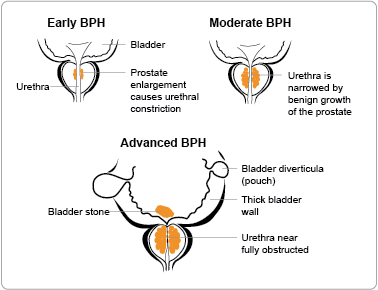Benign prostatic hypertrophy (BPH) and prostate cancer are the most common

benign and malignant neoplasias, respectively, in aging men in the USA. An estimated 189 000 new cases of prostate cancer are expected in 2002; this figure represents a relative levelling of annual incidence, following a sharp peak and subsequent decline in the early 1990s with the introduction of prostate-specific antigen (PSA) screening in a previously unscreened population2. The histological prevalence is higher: autopsy studies have found prostate cancer with volume >0.5 ml or extracapsular spread in 6.0% and 15.6% of men in their 50s and 70s, respectively.
An accurate epidemiological description of BPH is less straightforward, as the disease may be defined alternatively by histology, symptomatology and/or urodynamic parameters. The terms ‘lower urinary tract symptoms (LUTS)’ and ‘prostatism’ are often used synonymously with BPH, although they may define somewhat distinct patient populations. Autopsy studies have found histological BPH in over 40% of men in their 50s, and in nearly 90% of men in their 80s. Population-based studies of older men with no documented history of prostate pathology have found prevalence rates of LUTS varying from 35% among a cohort of Michigan men over age 60, to 80% of French men 50–80 years old. The prevalence of relatively severe symptoms in each of these cohorts was 15% and 13%, respectively.
If you looking for more informations about safety your health and you wish to minimize risk of developing BPH, just try to click here.
A number of recent studies have sought to characterize the prevalence of prostate cancer among patients with BPH. Among a referral population of 224 patients with LUTS, Lepor and colleagues reported a 6.7% rate of prostate cancer detection. Fowler and associates performed sextant biopsies on 128 patients with LUTS, negative digital rectal examination (DRE), PSA >4.0 ng/ml and prostate volume >75 ml. They found malignancy in 13%; of the 57 patients who underwent open prostatectomy, 11 and 4% were found to have pT1a and pT1b prostate cancer, respectively.
Other investigators have specifically analyzed the effects of PSA screening on prostate cancer detection among BPH patients. Mai and co-workers reviewed 533 transurethral resection of the prostate (TURP) specimens from 1989–90 and 449 specimens from 1997–99, finding cancer in 12.9% of the former and 8.0% of the latter; the trend was explained by a decrease in T1b rather than T1a tumors, suggesting a downward stage migration. Tombal and colleagues likewise reviewed 1648 BPH prostatectomy specimens over a 13-year period. They reported an 11 % incidence of prostate cancer, decreasing from 23 to 7% over the study period; like Mai and co-workers, they found the decrease to be explained by T1b tumors (15–2%), while the rate of T1a tumors remained nearly constant. Finally, Simons and colleagues compared prostate cancer mortality among Rhode Island men treated surgically for BPH with the population-based expected rate, and found no significant increased risk (relative risk 1.14, confidence interval 0.96– 1.33). The conclusion of a recent systematic review of the literature was that available data do not indicate a significantly elevated risk of prostate cancer among patients with BPH.
No epidemiological study to date has established an etiological role for BPH in the development of prostate cancer, although the two conditions share endocrine characteristics such as androgen dependence, as well as some common oncological features. The oncoprotein ErbB-2/Neu has been identified in both BPH and prostate cancer tissue; on the other hand, transforming growth factor-β1 exerts a mitogenic effect in prostate cancer but is pro-apoptotic in BPH. Other recent work on prostatic epithelial-stromal interactions has demonstrated that fibroblasts isolated from prostate cancer specimens can induce malignant transformation in epithelial cells derived from BPH tissue, but not from normal prostate glands.